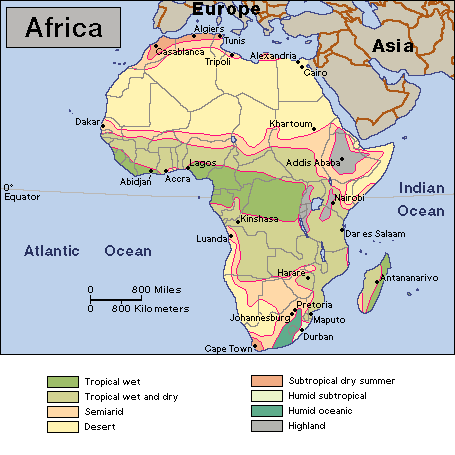 |
Content Spotlight
|
 |
|
African Climate
Much of Africa has a tropical or desert climate. The map and legend show what the climate is like throughout the continent.

Climate
Most of Africa has a warm or hot climate, but the humidity and amount of rainfall vary dramatically from area to area. The Climate map in the print version of The World Book Encyclopedia illustrates Africa's climate patterns.The maps with this article indicate the average January and July temperatures and the average yearly precipitation (rain, melted snow, and other forms of moisture).
Africa has the largest tropical area of any continent. The equator runs through the middle of Africa, and about 90 per cent of the continent lies within the tropics. In countries south of the equator, the seasons are opposite those of countries that lie north of the equator. But temperatures are high the year around almost everywhere in Africa. The variations between summer and winter temperatures are slight. In fact, the difference between daytime and nighttime temperatures in most parts of the continent is greater than the difference in the average temperatures between the coldest andwarmest months. For this reason, some people say that nighttime is the "winter" of the tropics.
Africa's highest temperatures occur in the Sahara and in parts of Somalia. The highest temperature ever recorded in the world was 136 degrees F. (58 degrees C) in the shade at Al Aziziyah, Libya, on Sept. 13, 1922. At I-n-Salah, Algeria, and along the north coast of Somalia, July temperatures soar to 115 degrees F. (46 degrees C) or higher almost every day. Nighttime temperatures, however, may drop sharply. The Sahara also has the greatest seasonal range of temperatures in Africa. Winter temperatures in the Sahara average from 50 degrees to 60 degrees F. (10 degrees to 16 degrees C). Near the equator, temperatures may average 75 degrees F. (24 degrees C) or more the year around. But temperatures of more than 100 degrees F. (38 degrees C) are rare.
The coolest regions in Africa are the northwest, the highland areas of the east, and parts of the south. In Johannesburg, South Africa, for example, the average temperature in January, the warmest month, is 68 degrees F. (20 degrees C). Frost and snowfall are common in the mountains of Africa.
Rainfall
Rainfall is distributed very unevenly in Africa. Most areas receive either too much rain or too little. In parts of the west coast, for example, annual rainfall averages more than 100 inches (250 centimeters). In Monrovia, Liberia, an average of more than 40 inches (100 centimeters) of rain falls during the month of June alone. In contrast, more than half of Africa receives less than 20 inches (50 centimeters) of rainfall yearly. The Sahara and the Namib Desert receive an average of less than 10 inches (25 centimeters) a year. In parts of the deserts, rain may not fall for six or seven years in a row. Then when it does rain, many children are startled because they have never seen rain before.
Rain falls the year around in the forests of the Congo Basin and the coastal regions of western Africa. But almost all the rest of Africa has one or two seasons of heavy rainfall separated by dry periods. In some regions of Africa, the amount of rainfall varies sharply from year to year rather than from season to season. Since the late 1960's, droughts have caused much suffering in Africa. Millions of Africans have died of starvation and related causes. The hardest-hit areas include Ethiopia and the Sahel region on the southern edge of the Sahara.
Africa's climate has made agricultural improvement difficult. In areas with limited and unreliable rainfall, farmers may be uncertain of what crops to plant. Some farmers grow a number of crops with different moisture needs in the hope of having at least one successful harvest. Other farmers may grow only one or two kinds of crops and risk starvation if not enough rain falls. In areas with too much rainfall, heavy downpours wash away nourishing substances in the soil. The hot, humid climate in much of Africa encourages the spread of insects that destroy livestock and cause various diseases in people.
return to top
|
